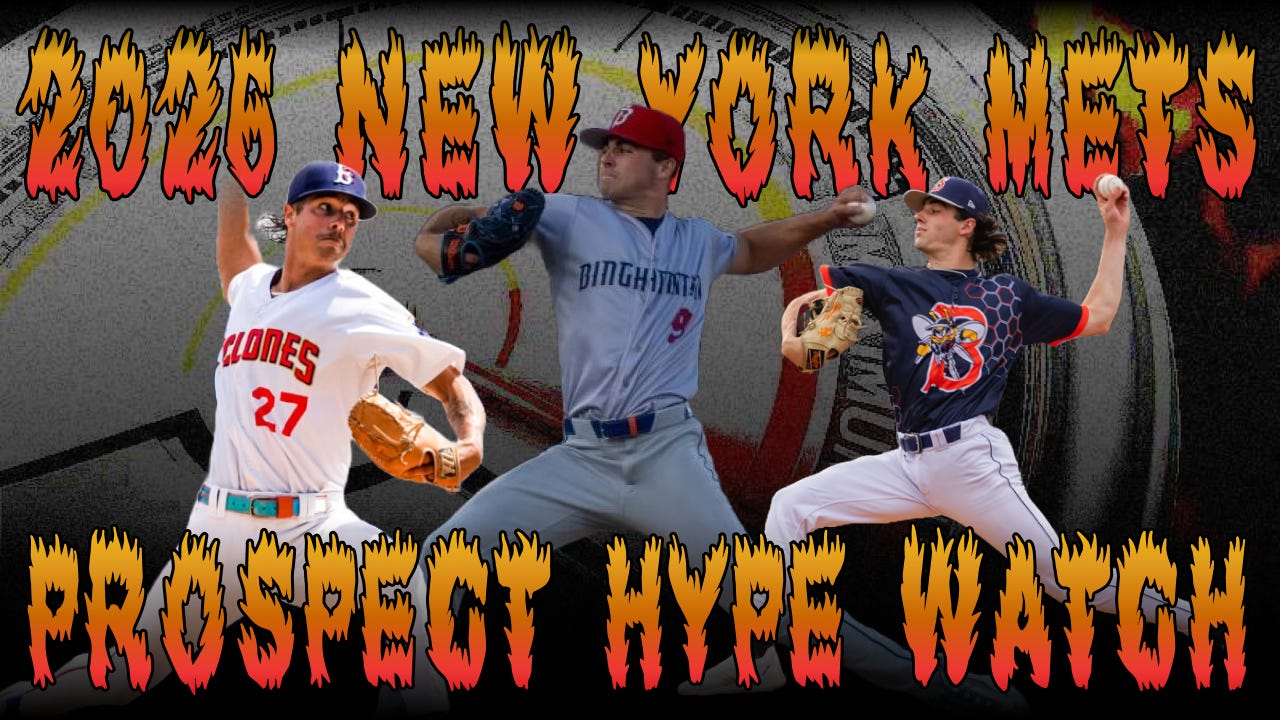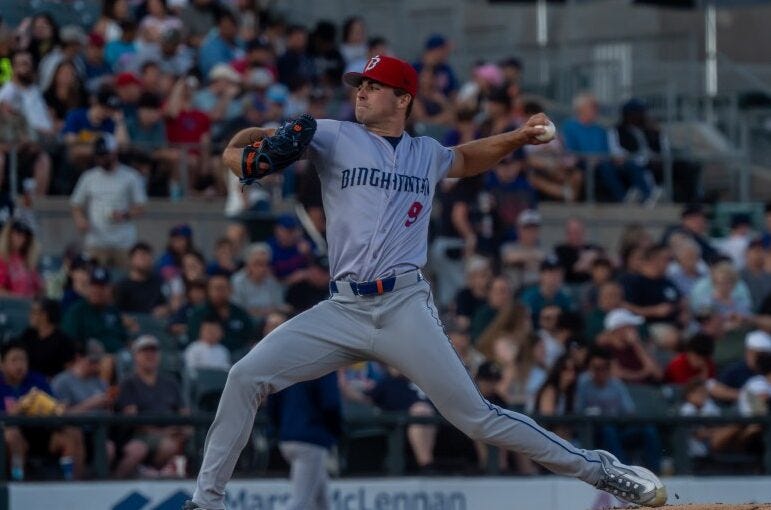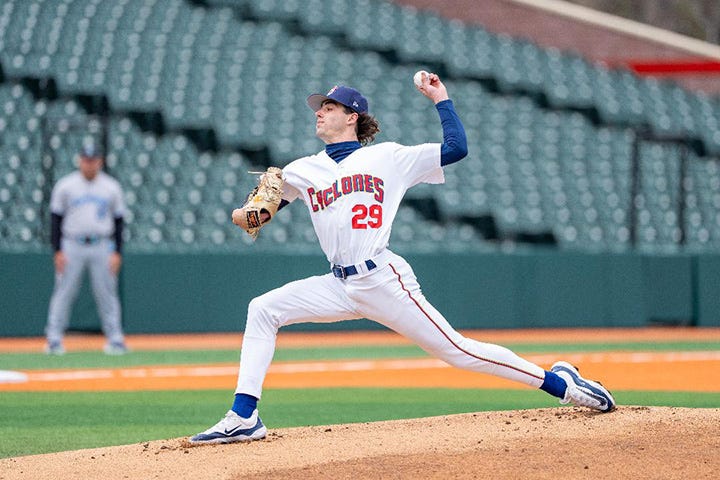Who are the next young studs for the Mets? (Pt. 2)
The Mets' minor league pitching development has recently been referred to as a 'juggernaut' — here are three reasons why.
I’ve often been accused of being a ‘prospect hugger’…and to an extent, the shoe fits.
Yet considering the talent that’s currently stockpiled in the Mets’ system, I don’t think it’s remotely ridiculous to want to cling to a significant chunk of these prospects. Rather, given the initial MLB success of Nolan McLean & Friends and the rapid ascension of multiple prospects with sustained success across levels, it doesn’t seem unwise to place a little extra faith in the Mets’ current development system these days.
In Part 1, I talked about three position player prospects (Jacob Reimer, A.J. Ewing, and Chris Suero) that I’m particularly stoked about. Today, I’ll be looking at three pitching prospects whose notably high ceilings have piqued my interest: Will Watson, Jonathan Santucci, and Zach Thornton.
As a quick reminder: prospects are graded on six key tools using a scale called the 20-80 scale. Position players are graded on their hitting, power, speed, arm strength, and fielding tools; pitchers are graded on the quality of their pitches (usually their fastball, curveball, slider, and changeup), as well as their command of their stuff.
For pitch type grades, most of the abbreviations should be self-explanatory, but for clarity:
FB: Fastball
CU: Curveball
SL: Slider
CH: Changeup
FC: Cutter
The grading scale in question:
20-30: Horrible.
40: Meh.
50: Average.
60: All-Star.
70-80: Freak.
Ok. Let’s talk arms.
RHP Will Watson (No. 11 prospect, Double-A BNG)
2025 MiLB Totals: 28 G (23 GS), 121.1 IP, 2.60 ERA,1.20 WHIP, 142 K, 28.5 K%, 11.6 BB%, 3.53 FIP, 10.53 K/9, 0.59 HR/9
Latest Grades: FB: 60 / SL: 50 / CH: 50 / FC: 45 / Control: 45 / Overall: 45
After initially spending two years at two different schools before being drafted by the Mariners in 2023, Will Watson chose to take his chances at USC. After starting the season in the Trojans’ bullpen, he transitioned into a starter role midseason, making nine starts to the tune of a 3.93 ERA. The Mets landed him in the seventh round of the 2024 draft, and his shift to full-time starter continued.
So far, said shift has gone well: in his first full year as a starting pitcher, Watson delivered a 2.60 ERA, which ranked sixth among starters with at least 120 innings. His 142 strikeouts were a top-20 mark in MiLB, and his 10.53 K/9 ranked eighth in his group.
Watson’s pitch mix leans mostly on a fastball that sits at a cool 95 mph but gets up to 97. He works in a changeup and slider that are both equally devastating working off the heater, breaking in opposite directions moments before crossing the plate, diving in or away from hitters that have likely already swung over them.
With Watson, the primary red flag is his control issues. Granted, he’s steadily brought his walk rate down after kicking off his Minor League career with a near-5.00 BB/9 rate, but that ‘improved’ rate of 4.34 BB/9 still ranked 93rd out of 105 qualified pitchers, so free bases remain a concern.
Still, looking at his arsenal and the way he’s been deploying it so far, the potential here feels sky high. The changeup looks absolutely gross in the tape I’ve seen, and though he issued more walks than is ideal this season, he also held opposing hitters to just a .202 average while allowing a measly eight homers and stranding 80% of the runners he gained in 2025.
I have a feeling he’ll get it all figured out. Don’t be shocked if he makes a random middle-relief appearance in August.
LHP Jonathan Santucci (No. 14 prospect, Double-A BNG)
2025 MiLB Totals: 25 G (23 GS), 117.2 IP, 3.06 ERA,1.16 WHIP, 138 K, 28.7 K%, 8.5 BB%, 3.12 FIP, 10.56 K/9, 0.69 HR/9
Latest Grades: FB: 55 / SL: 60 / CH: 50 / Control: 45 / Overall: 45
Originally expected to be a first-round draft selection out of Duke, the Mets landed Jonathan Santucci in the second round of last year’s MLB draft. In his final college season, Santucci delivered a 6-1 record with a 3.41 ERA and a 1.310 WHIP over 58 innings of work, good enough to earn the faith of Mets brass.
That faith is already being rewarded.
Despite posting an ERA north of 8.00 in his first six games, Santucci’s inaugural professional season wound up going wonderfully: he finished the season with a 9-4 record and a 3.06 ERA across 117.2 innings. He tallied 138 strikeouts against just 41 walks, good for a minuscule 1.16 WHIP.
Much like Watson, Santucci finds much of his strikeout success by utilizing his plus-grade fastball to set up a devastating offspeed pitch; in this case, it’s his absolutely lethal slider. The fastball usually sits around 95 mph and has a ton of zip on it when it’s at its best, with just enough arm-side run that it leaks away from righty barrels and inches in on lefty hands as it crosses the plate. The slider, on the other hand, tears a diagonal line through the strike zone, which can do incredible damage depending on its angle and placement. Santucci throws it around 85 mph, but it looks like it’s arriving at the plate faster than that; I’d love to get my hands on his spin rate data to see exactly what we’re dealing with on this pitch. I can already see this combo working very well for Santucci at the major league level.
Between him and Watson, I think Watson would be the more likely of the two to have a shot at MLB camp this spring, especially considering the state of the bullpen and the team’s immediate needs. However, Santucci’s name is one I see being a first-in-line candidate for a September cup of coffee should his development continue on its current trajectory.
LHP Zach Thornton (No. 23 prospect, Double-A BNG)
2025 MiLB Totals: 14 G (14 GS), 72.2 IP, 1.98 ERA, 0.81 WHIP, 78 K, 28.5 K%, 4.0 BB%, 2.60 FIP, 9.66 K/9, 0.62 HR/9
Latest Grades: FB: 45 / CU: 45 / SL: 50 / CH: 45 / FC: 45 / Control: 60 / Overall: 40
While the other two names on this list feel like more obvious picks, I think Zach Thornton is my ‘sleeper’ favorite of the upcoming batch of arms…insomuch as a guy who posted a 0.81 WHIP over 72.2 innings can be called a ‘sleeper.’
Before being sidelined with an oblique injury in June, Thornton was yet another Mets minor leaguer cruising his way through the system. His WHIP led all of MiLB among starters with at least 70 innings, his 1.96 ERA ranked 12th, and he issued just 11 walks. Eleven! In more than 70 innings!
Thornton’s repertoire will play on any stage, and it’s likely going to age very well. Since his fastball usually sits in the low-to-mid 90s, Thornton relies much more on finesse and his deep pitch mix than he does on velocity to get guys out. Though his 9.66 K/9 looks low compared to Watson’s and Santucci’s, it’s also reflective of a 2.51 K/9 increase in just one season. That’s a pretty encouraging trend.
Another good sign is his steadily decreasing FIP. After posting a 4.88 in Single-A in 2024, he brought it all the way down to 2.96 after his High-A promotion to bring his season mark to a respectable 3.88. This year, he continued that progress, opening his season with a 2.18 mark at High-A, followed by a 2.77 at Double-A before being sidelined. The fact that Thornton has been able to increase his strikeout rate so significantly (28.5% in 2025) while keeping his walks minimal (4.0%) and not generating an overwhelming swinging strike rate tells us that Thornton is an elite pitch locator; the eye test confirms as much. He deploys a plethora of pitch types, and so far, he’s been able to place them all effectively.
The main thing to watch with Thornton heading into 2026, naturally, is his health — obliques are infamously tricky. That said, if he’s back to 100% to start the spring, he should be in Syracuse by summer at the latest; should he pick up right where he left off, I think he’s yet another instant cup of coffee candidate, depending on the state of the rotation.
And there we have it: three position players and three pitchers I think we should all be paying close attention to during the upcoming season.
Without question, this is the strongest farm system the Mets have had in quite a long time. In fact, ESPN ranked it as MLB’s best as recently as August of this year; Baseball America gave it an ‘A’ grade in September. If there was ever a time to prospect hug, it’s now — especially in the pitching department.
There are plenty of prospects that I could have discussed in these two pieces, and I will likely cover them very soon; Jack Wenninger and R.J. Gordon could easily have been included in this list. I’m sure this will be a fairly unpopular opinion, but looking at the numbers and the respective wealth of talent this team seems to have at its disposal…I can’t say that I blame Stearns for holding as firm at the deadline as he did. It may not have helped them in 2025, but if even a quarter of the current group of prospects ends up panning out in the big leagues, the roster will be in terrific shape for years to come. I’m thrilled they didn’t hemorrhage key prospects for rentals, and I hope that policy continues (yes, even if Skubal’s available.)
Call me a prospect hugger all you want; that’s fine with me. All I know is I can’t wait to see these players in action alongside the big league club.
Is it Spring Training yet?







Thanks for putting a word in for Stearns, who gets more grief than I think he deserves. Montas was his only really bad decision. A lot of this year's disappointment was nobody's fault , just players that didn't perform. Regarding Skenes: IF he can be signed long term, I'd trade anybody not named McLean to get him. Note to Uncle Steve: pony up for Bellinger!
Considering all that went down in '25, and the serious roller coaster rides we Mets fans have benn on over the past five (or more!) seasons, you give us something to hold on to. Hope. #LFGM